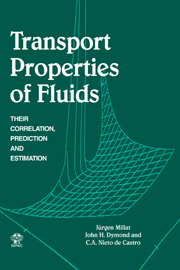Book contents
8 - Equations of State
Published online by Cambridge University Press: 07 October 2009
Summary
Introduction
The purpose of this chapter, in a book about transport properties, is to give advice to the reader on the best methods for converting the data, which are usually measured as a function of P and T, to a function of ρ and T, which is the form required for the correlating equations; and, in addition, to provide sources for values of the ideal–gas isobaric heat capacities, which are also required for the transport–property calculations. Both of these purposes can be fulfilled by calculations from a single equation of state which has been fitted to the whole thermodynamic surface. Heat capacities of the real fluid are required only for the calculation of the critical enhancement of the thermal conductivity and viscosity, as described in Chapter 6; discussion of these properties in this chapter will be restricted to Section 8.4.4.
An equation of state for a pure fluid relates the various equilibrium thermodynamic properties to one another and will usually be largely an empirical function, although at the limits it will approach theoretical values. In general, entirely theoretical equations of state are unable to represent measured data to within their experimental accuracy. If the accuracy of the calculated transport properties is to be as high as possible, it is important that the most accurate equation of state be used for calculating the appropriate densities.
- Type
- Chapter
- Information
- Transport Properties of FluidsTheir Correlation, Prediction and Estimation, pp. 165 - 186Publisher: Cambridge University PressPrint publication year: 1996

